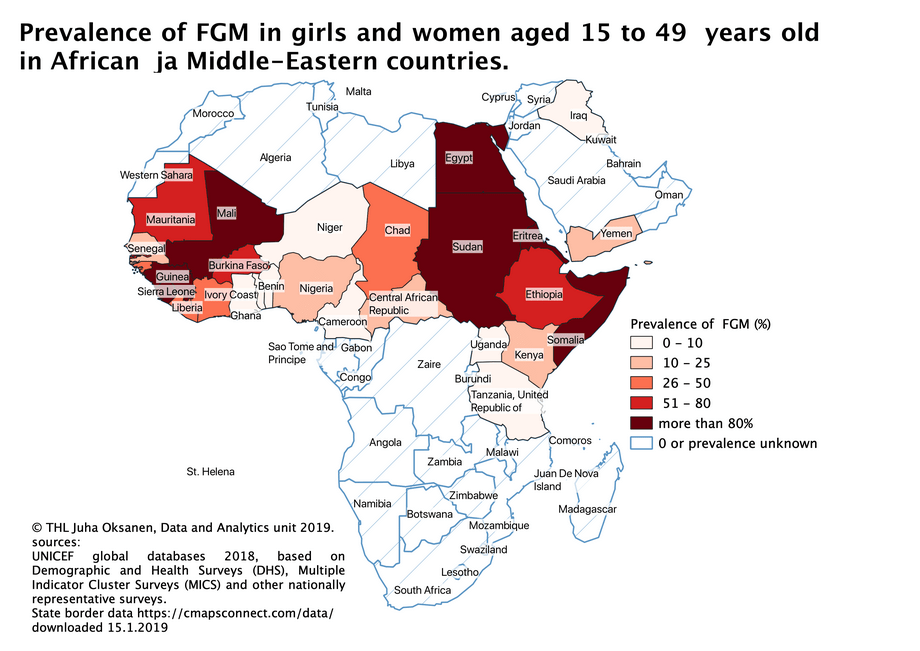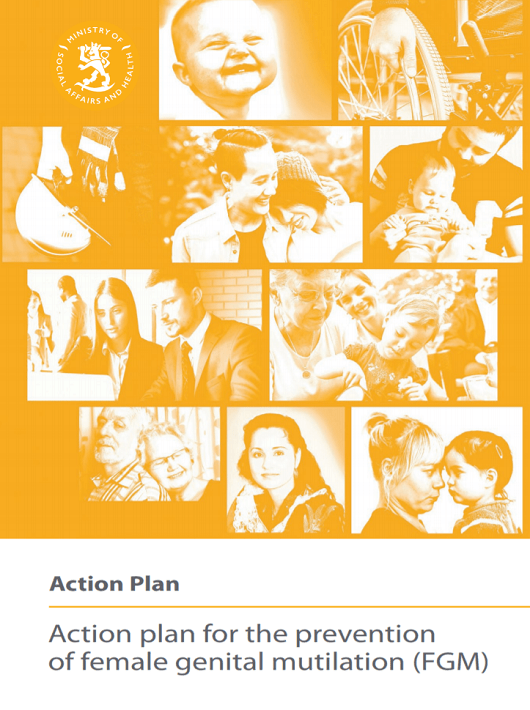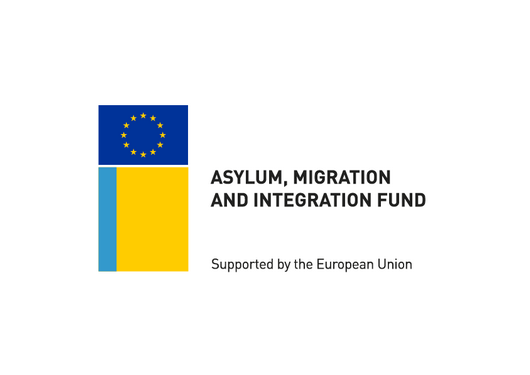Prevention of female genital mutilation (FGM)
- What is female genital mutilation?
- International agreements and Finnish legislation
- Where does female genital mutilation occur?
- Why are female genital organs mutilated?
- THL studies on the prevalence of female genital mutilation
What is female genital mutilation?
Female genital mutilation (female circumcision or FGM) refers to all non-medical measures involving removal of women's external genital organs or damaging the female genital organs in some other way.
FGM is carried out for cultural or other non-medical reasons.
Girls' genital organs are normally mutilated between infancy and the age of 15. The age when genital mutilation is carried out varies greatly between countries, regions and ethnic groups. Girls and women may experience genital mutilation
- as infants
- as preschoolers
- at school age
- as teenagers
- during their first pregnancy
- after giving birth
International agreements and Finnish legislation
FGM is a tradition that violates human rights. It violates several international human rights treaties, including
- The UN Universal Declaration of Human Rights (1948)
- The UN Convention on the Elimination of Discrimination against Women (1979)
- The UN Convention on the Rights of the Child (1989)
- The Council of Europe's Convention on preventing and combating violence against women and domestic violence (the Istanbul Convention 2015)
Finland is committed to these international agreements, which promote women's and children's human rights and prevent violence against women.
Female genital mutilation is a crime
In Finland, FGM and its preparation are punishable under the Criminal Code of Finland. Preparation can mean, for example, taking a woman or a girl abroad to be mutilated, or forcing or persuading them to be mutilated. The maximum penalty for FGM is 10 years in prison. The limitation period for prosecution of genital mutilation and the crime of preparation of genital mutilation committed against a girl under the age of 18 starts when the girl turns 18 and lasts for 20 years.
A family member may also be guilty of committing a crime if they do not themselves carry out the genital mutilation but arrange for it to take place or provide assistance for it.
If a Finnish citizen or equivalent person, such as a foreigner residing permanently in Finland, commits FGM abroad, the act is a punishable offence even if it does not contravene the legislation of the country in question.
If a professional suspects that a girl is at risk of FGM or has undergone FGM while living in Finland, they should first bring it up with the girl and her parents. In addition to this discussion, the professional is obliged to submit a child welfare notification to the social welfare authorities and a report to the police.
Where does female genital mutilation occur?
There are an estimated 200 million girls and women currently alive who have undergone FGM. Every year, about four million girls are at risk of being mutilated.

Prevalence of FGM in girls and women aged 15 to 49 years old in African and Middle-Eastern countries. Click on the image to enlarge.
Prevalence of FGM varies by region:
- High prevalence: Somalia, Guinea, Djibouti, Sierra Leone, Mali, Egypt, Sudan, Eritrea
- Fairly high prevalence: Burkina Faso, Gambia, Ethiopia, Mauritania, Liberia, Guinea-Bissau, Chad, Côte d'Ivoire, Nigeria, Senegal, Central African Republic, Kenya, Indonesia
- Low prevalence or the prevalence varies regionally: Yemen, Tanzania, Benin, Togo, Ghana, Niger, Uganda, Cameroon, Afghanistan, Kurdish Areas (Iran, Iraq, Syria, Turkey), Thailand, Pakistan, Eastern European countries Georgia and Dagestan, India
In Finland, female genital mutilation became a topical issue in the 1990s. At that time, refugees started arriving in Finland from areas where this tradition was practised.
Why are female genital organs mutilated?
A variety of reasons are given for the tradition, and these vary from one country, region and culture to the other.
Cultural reasons
- Female genital mutilation is an ancient tradition.
- The tradition aims to maintain cultural identity.
- Cultural continuity is considered important.
Religious reasons
- No religion requires female genital mutilation, although it is often done in the name of religion.
- The tradition is practised by many religious groups, such as Muslims, Jews, Christians and animists.
Moral reasons
- Genital mutilation is used to ensure a girl's virginity.
- A girl who has undergone FGM is considered honourable and fit for marriage.
Cleanliness Reasons
- In many cultures, female genital mutilation is a so-called "cleansing surgery" that removes genital organs that are considered impure or masculine.
- Genital mutilation is believed to increase hygiene: dirt cannot get into the vagina and it is thought to protect against certain diseases.
Ethical reasons
- A girl who has undergone FGM is considered beautiful in her own community.
- Reasons related to sexuality
- Genital mutilation is used to make girls into women.
- The tradition is believed to curb the oversexed nature of the woman.
- Genital mutilation is believed to improve sex life.
Financial reasons
- A daughter who has undergone FGM is valuable to their family.
- In some cultures, there is a bride price which the family receives as a form of compensation for their daughter when she enters the husband's family
Social reasons
- Genital mutilation supports the sense of social cohesion.
- The family may face discrimination from its own community if their daughter does not undergo FGM.
- Social pressure to continue the tradition may be significant.
THL studies on the prevalence of female genital mutilation
In recent years, many of the THL population surveys have given consideration to female genital mutilation.
- Maahanmuuttajien terveys- ja hyvinvointitutkimus (Maamu)
- UTH - Ulkomaista syntyperää olevien työ ja hyvinvointi -tutkimus
- Turvapaikanhakijoiden alkuterveystarkastuksen valtakunnallinen kehittämishanke (TERTTU)
- Kouluterveyskysely
- Ulkomailla syntyneiden hyvinvointitutkimus (FinMonik)
Further information
- Koukkula, M. & Klemetti, R. 2019. Action plan for the prevention of female genital mutilation (FGM). Ministry of Social Affairs and Health. Publications. 1/2019.
- UNICEF. 2018. UNICEF global databases 2018.
- Child Welfare Act, Section 25 Duty to notify (Finlex) (PDF 240 KB)
- Child Welfare Act, Section 26 Initiation of proceedings in a child welfare case and the start of a client relationship (Finlex) (PDF 240 KB)
- Criminal Code, Chapter 21: Homicide and bodily injury (Finlex) (PDF 774 KB)
- Convention on the Rights of the Child (Unicef)

Nollalinja
Nollalinja provides help in nine different languages.
There is a chat service on the website.
Professionals can also consult with Nollalinja.

Action plan for the prevention of female genital mutilation (FGM)

.jpg/b757e827-68b0-6a8a-2c7a-6628cf451713?t=1737470530837)
Prevention of female genital mutilation (FGM)
Prevention of female genital mutilation (FGM) (Amharic)
Prevention of female genital mutilation (FGM) (Arabic)
Prevention of female genital mutilation (FGM) (Dari)
Prevention of female genital mutilation (FGM) (Persian)
Prevention of female genital mutilation (FGM) (French)




